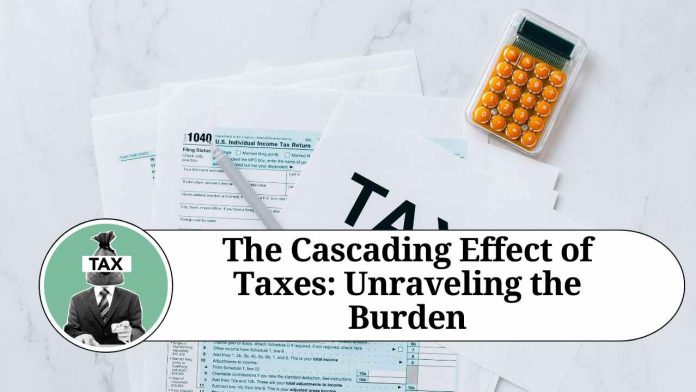Introduction
Taxes play a fundamental role in financing government operations and providing public services. They are necessary for a functioning society, but their implementation can often lead to unintended consequences. One such consequence is the cascading effect of taxes, also known as tax pyramiding. This phenomenon occurs when taxes are levied at multiple stages of production or distribution, resulting in an accumulative burden that trickles down to consumers. In this blog post, we will explore the cascading effect of taxes, its implications, and potential solutions.
Understanding the Cascading Effect
The cascading effect of taxes arises when a tax is imposed at each stage of production or distribution of a product or service. As the product moves through various stages, each entity involved incurs a tax liability, leading to an accumulation of taxes. This results in an increased cost of production, which is ultimately borne by the end consumer. The cumulative effect of multiple taxes can significantly inflate the final price of goods or services, leading to market distortions and economic inefficiencies.
Implications of Tax Cascading
- Inflationary Pressure: The cascading effect of taxes contributes to an increase in the overall cost of goods and services. When businesses are burdened with multiple layers of taxes, they pass on the additional costs to consumers. This inflationary pressure can erode purchasing power and reduce consumer welfare.
- Distorted Pricing: Tax cascading distorts the pricing structure by artificially inflating the cost of goods. It creates an uneven playing field, particularly for small businesses, who struggle to compete with larger enterprises that can absorb the tax burden more easily. This can stifle competition and hinder economic growth.
- Reduced Investment and Employment: High tax burdens resulting from cascading effect discourage investment and expansion. Businesses may hesitate to invest in new ventures or upgrade their facilities due to the increased costs. Consequently, this can lead to a slowdown in economic activity and a decline in job creation.
- Complex Tax Compliance: Tax cascading adds complexity to the tax system, making it more difficult for businesses to comply with regulations. Multiple tax rates and exemptions across different stages of production or distribution create administrative burdens, increasing compliance costs for businesses.
Potential Solutions
- Input Tax Credit: One way to mitigate the cascading effect of taxes is by implementing an input tax credit system. This system allows businesses to claim credits for the taxes paid on inputs or raw materials used in the production process. By offsetting the taxes paid at earlier stages, businesses can reduce their overall tax liability and avoid double taxation.
- Harmonization and Simplification: Governments can work towards harmonizing tax rates across different stages of production or distribution. By simplifying the tax structure, businesses can navigate the system more easily, reducing compliance costs and administrative burdens.
- GST or VAT Systems: Implementing a Goods and Services Tax (GST) or Value-Added Tax (VAT) system can help address tax cascading. These systems involve levying taxes only on the value added at each stage of production, allowing for the adjustment of input tax credits. GST and VAT systems promote transparency and reduce the cascading effect by ensuring that taxes are levied on the value addition at each stage.
- Regular Tax Reviews: Governments should periodically review and evaluate the tax system to identify and rectify instances of tax cascading. This can involve engaging with stakeholders, including businesses and industry associations, to gather insights and suggestions for improvement.
Conclusion
The cascading effect of taxes is a complex issue with far-reaching implications for businesses and consumers alike. It distorts market dynamics, contributes to inflation, and hampers economic growth. By implementing measures such as input tax credits, harmonization, and simplification,
Other Related Blogs: Section 144B Income Tax Act
Frequently Asked Questions (FAQs)
Q1: What is the cascading effect of taxes?
The cascading effect of taxes, also known as tax pyramiding, occurs when taxes are levied at multiple stages of production or distribution. This leads to an accumulation of taxes, resulting in increased costs for businesses and ultimately passed on to consumers.
Q2: How does the cascading effect of taxes impact consumers?
The cascading effect of taxes increases the cost of goods and services, leading to inflationary pressure. Consumers end up paying higher prices, which can reduce their purchasing power and overall welfare.
Q3: What are the implications of tax cascading for businesses?
Tax cascading creates an uneven playing field, with small businesses being disproportionately affected. It distorts pricing structures, hampers competition, and discourages investment and job creation due to increased costs.
Q4: Can tax cascading be avoided or minimized?
Tax cascading can be mitigated through various measures. Implementing an input tax credit system allows businesses to offset taxes paid on inputs or raw materials, reducing their overall tax liability. Harmonization and simplification of tax rates and structures, as well as the adoption of GST or VAT systems, can also minimize the cascading effect.
Q5: How does an input tax credit system work?
An input tax credit system enables businesses to claim credits for the taxes paid on inputs or raw materials used in the production process. By offsetting the taxes paid at earlier stages, businesses can reduce their overall tax liability and avoid double taxation.
Q6: What are GST and VAT systems, and how do they address tax cascading?
GST (Goods and Services Tax) and VAT (Value-Added Tax) systems are consumption-based tax systems that are designed to minimize tax cascading. These systems involve levying taxes only on the value added at each stage of production or distribution, allowing for the adjustment of input tax credits. By taxing only the value addition, GST and VAT systems reduce the cascading effect and promote transparency in taxation.
Q7: How can governments address the issue of tax cascading?
Governments can address tax cascading by regularly reviewing and evaluating the tax system to identify and rectify instances of cascading. They can also work towards harmonizing tax rates, simplifying the tax structure, and engaging with businesses and industry associations to gather insights and suggestions for improvement.
Q8: What are the benefits of reducing the cascading effect of taxes?
Reducing the cascading effect of taxes brings several benefits. It promotes a more competitive business environment, encourages investment and job creation, enhances market efficiency, and ensures that consumers pay fair prices for goods and services.
Q9: Are there any international examples of successful measures to tackle tax cascading?
Yes, several countries have implemented measures to tackle tax cascading. For example, India introduced a comprehensive GST system in 2017, replacing multiple indirect taxes. This reform aimed to reduce tax cascading and simplify the tax structure. Other countries, such as Australia, Canada, and many European nations, have also adopted VAT systems to address the issue of tax cascading.




















